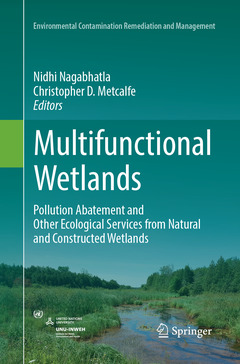Multifunctional Wetlands, Softcover reprint of the original 1st ed. 2018 Pollution Abatement and Other Ecological Services from Natural and Constructed Wetlands Environmental Contamination Remediation and Management Series

This book describes how natural or constructed wetlands can be used to reduce pollution of freshwater and coastal ecosystems, while still preserving their biodiversity and ecological functions. Through a series of case histories described in 10 chapters in the monograph, the readers will gain an understanding of the opportunities, as well as the challenges associated with reducing point and non-point source pollution using natural, restored or constructed wetlands. The target audience will be water practitioners involved in projects utilizing integrated watershed management approaches to pollution abatement, as well as researchers who are designing projects focused on this topic.
Chapter 1. Multifunctional Wetlands: An Overview of Pollution Abatement by Natural and Constructed Wetland Ecosystems.– Chapter 2. Using Natural Wetlands for Municipal Effluent Assimilation: A Half-Century of Experience for the Mississippi Delta and Surrounding Environs.- Chapter 3. The Use of Natural Tundra Wetlands to Treat Domestic Wastewater in Canada’s Far North.- Chapter 4. The Long-term Use of Treatment Wetlands for Total Phosphorus Removal: Can Performance Be Rejuvenated with Adaptive Management?.– Chapter 5. An Investment Strategy for Reducing Disaster Risks and Coastal Pollution Using Nature Based Solutions.– Chapter 6. The Role of Constructed Wetlands in Creating Water Sensitive Cities.– Chapter 7. Methylmercury in Managed Wetlands.– Chapter 8. Growing Ornamental Flowers and Fish in Indigenous Communities in Mexico: An Incentive Model for Pollution Abatement Using Constructed Wetlands.– Chapter 9. Phytoremediation Eco-Models Using Indigenous Macrophytes and Phytomat
erials.– Chapter 10. Accumulation of Metals by Mangrove Species and the Potential for Bioremediation.Nidhi Nagabhatla is a Programme Officer with the UN University – Institute for Water, Environment and Health. She is a natural systems science specialist and a geospatial analyst and she has led, coordinated and implemented transdisciplinary projects and worked with multi-disciplinary research teams in various geographical regions and in varied thematic domains related to water and ecosystems, particularly in Asia, South Africa and West European regions. She has worked for more than 15 years with multiple international organizations (IWMI, World Fish Centre and IUCN), leading research and capacity development initiatives related to the themes of water and wetlands.
Date de parution : 09-2018
Ouvrage de 308 p.
15.5x23.5 cm
Date de parution : 11-2017
Ouvrage de 308 p.
15.5x23.5 cm



